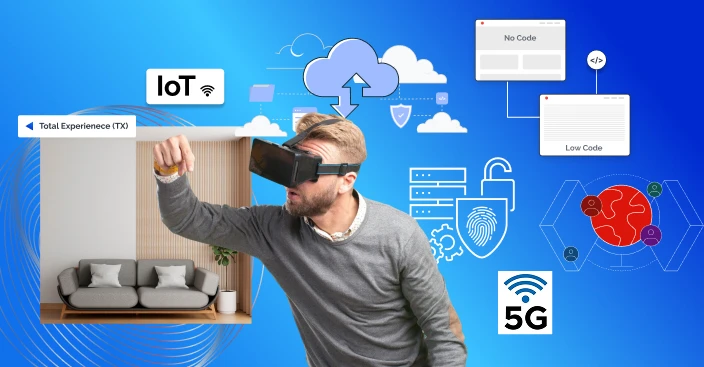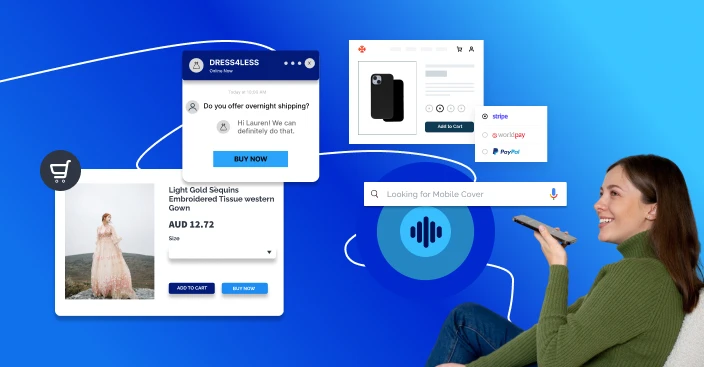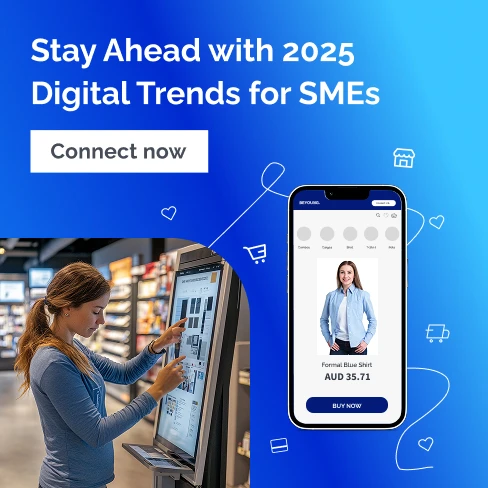Key Digital Transformation Trends for Australian SMEs in 2025

Technology innovation occurring at a breakneck pace in this day and age has moved digital transformation from being an option to a need.
2025 is a year to make-or-break for Australian SMEs, freshly give a choice to stimulate their models of business models, encourage the acquisition of digital assets, and make selections based on long-term development. A recent study has found that 74% of brands consider digital transformation a top priority.
The question is-what is digital maturity? How can Australian SMEs start on this pathway with their limited resources?
To unwrap dynamics around the changing landscape of digital transformation and its effects on Australian SMEs, we will examine some of the cardinal themes to watch in 2025.
Understanding Digital Maturity for Australian SMEs
The Australian business that will emerge in 2025 is unpredictable. Growth SMEs are facing challenges, including changing client expectations, legislative conditions, and global competition.
Not only is it the adoption of digital technologies, but also a continuous spirit of improvement, data-driven decision-making, and customer-driven innovation.
Australian SME digital maturity in 2025 comprises customer focus, cloud-readiness, data literacy, and responsiveness. It comprises bridging the digital divide between the country and the cities, and industry-based and data protection legislation compliance.
It is not necessarily the implementation of new technology, but applying the right technology to fix problems, achieve efficiency, improve the customer experience, and build systems that scale.
Why Digital Maturity is More Important Than Ever
The forthcoming Australian business is unpredictable. SMEs struggle with a myriad of issues such as changing customer expectations, legislative conditions, and increased competition across the globe
Digital maturity gives businesses the footing on which to stand strong and be nimble under these circumstances.
Arguably, one of the strongest motivators for digital maturity adoption is the growing expectation from Australian consumers for seamless, digital-born experiences.
Speed, convenience, and personalisation are what people now demand, and those organisations that are unable to provide them will find themselves in the rearview mirror.
And, on top of that, operational effectiveness isn’t a dream anymore; it’s a necessity. Digitally mature businesses can be able to simplify operations, automate things that are repetitive in nature, and have insights at hand to make better decisions.
Digital transformation also provides access to global markets. With digital tools in the proper place, even an Australian bush SME can sell worldwide or offer services to worldwide customers.
This scalability without geographic limitation is one of the most important advantages of our time under globalisation.
Most importantly, digital maturity results in innovation and continuous development. Firms that adopt this business model will be most likely to shift gears during slow times, test new business models, and dominate their markets.
Top Digital Transformation Trends for Australian SMEs in 2025
AI and Automation for Smooth Operations
Artificial intelligence solutions are now more available to SMEs to assist with intelligent automated customer care, marketing, inventory management, and HR functions.
Artificial intelligence-based chatbots, automated marketing systems, and artificial intelligence-based analytical solutions enable small businesses to do more with less.
In fact, for instance, professional services firms like law firms, consultancies, or real estate brokerages have begun implementing AI to automate client interactions, appointment setting, and content generation.
Cloud-Native Applications and Offsite Collaboration
Cloud deployment is increasing in Australia. Cloud-native applications are making mission-critical business software available to SMEs at any place and at any time.
It is particularly suited to rural SMEs that do not have any physical infrastructure but would like to stay connected with clients in cities or to off-site workers.
MYOB, Xero, Microsoft 365, Google Workspace, and other technologies offer secure, scalable collaboration spaces, accounting, and project management.

These are Australian compliance-centred with excellent cybersecurity features and local data hosting.
Data-Driven Decision Making
Australian SMEs are at last recognising the potential of tapping into data, rather than warehousing it. Data literacy is a 2025 business imperative.
Non-technical employees should be able to crack open customer information, web analytics, and sales data to make business decisions.
These technologies are enabling SMEs to build interactive dashboards tracking KPI in real-time. This means business leaders are able to respond ahead of the game instead of playing catch-up.
Digital Customer Experience (CX)
Customer experience remains a 2025 differentiator. From mobile-optimised websites and contextualised email experiences through to omni-channel service, SMEs are concentrating on frictionless digital experiences.
Australian customers are digitally savvy. The brand can expect frictionless, immediate assistance and safe payment procedure. Based on recent analysis, it’s been found that 49% of users who left a brand in the past 12 months are due to poor CX.
With the help of a seamless integration of the platform, like Shopify, Salesforce, HubSpot, or Zoho will be SMEs to deliver best-in-class services for the aussies market.
Cybersecurity and Compliance
The more digitisation, the riskier. Cybersecurity is critical to SMEs for the Australian Privacy Act and sector-specific regulations and adherence.
We have multi-factor authentication, endpoint security, employee cybersecurity awareness training, and regular auditing in place.
The majority of SMEs already have cyber insurance and managed service providers in place, so there is real-time monitoring.
Local SEO and Hyper-Personalisation
For local small and medium businesses like health services, consultants, or tradies, being local matters.
Google’s algorithms in 2025 still love hyper-relevant and local content. Businesses that are optimising for local SEO, collecting genuine reviews, and localising web and email interactions are beating their competitors.
AI-based, real-time location-based, user-history-based, and customer-segmented personalisation of content is the new reality, and thus every interaction matters.
Ethical Innovation and Sustainability Tech
More and more Australians are demanding green businesses. Small and medium enterprises are employing digital platforms for carbon tracking, de-risking supply chains, and carrying out communications about sustainability.
Digital transformation is as much about meaning as about money. Ethical innovation, using digital technology to uplift lives, minimise waste, and empower individuals, is gaining momentum.
Implementation of Digital Twin Technology
Digital twin technology, or virtual replicas of physical assets, is being widely adopted by innovative SMEs.
It was initially utilised in manufacturing and construction, but currently, it is being utilised even in logistics, supply chain management, and even service design.
It assists companies to model scenarios, forecast outcomes, and make decisions in advance.
Embedded Finance in Digital Platforms
Finance technology is being integrated into web portals in a simple manner, and this is facilitating SMEs to make payments, lending, and credit using their present devices.
This is making the finance operations simpler as well as more accessible to people, especially small businesses that had to deal with multiple service providers in bookkeeping and banking before.
Voice Search and Conversational Commerce
As more Australians utilise voice devices, voice search optimisation and conversational commerce are gaining traction.

SMEs are now developing more websites and digital touchpoints that will be responsive to voice searches, allowing customers to easily search for services, make appointments, or purchase products without necessarily doing it in person.
Digital Transformation for Regional Australian SMEs
Regional SMEs are typically beset by poor internet, awful technical support, or a lack of finance.
But through government programs such as the Digital Solutions Program and NBN deployment, regional SMEs have never been better connected to the technology needed.
Cloud-based solutions and mobile-first applications work best for regional SMEs. They break away from reliance on internal infrastructure and enable teams to work together regardless of distance.
Other than that, rural towns and businesses are also being provided with grants and digital upskilling packages from the state governments and councils so that they can be developed with the upskills.
How to Measure Your Digital Maturity
Now, before you can set a change program in action, you must evaluate where you stand at present in terms of digital maturity. This will enable you to see strengths, expose gaps, and have a clear investment strategy.
Step 1: Review Your Digital Strategy
Begin by taking a look at your digital strategy, that unique plan that defines how digital technology enables the overall business objective. Having a unique strategy will direct all of the choices that you make as you embark on your transformation.
Step 2: Examine Your Tools and Technologies
Then it’s necessary to review your tools and technologies. Check whether they are secure, scalable, and connected, and if that is possible with a standalone or legacy system, or if some other approach is necessary for increasing the business growth and productivity.
Step 3: Assess People and Abilities
Don’t forget, digital maturity is people- and technology-related. Think through whether your workers possess the digital skills and training required to thrive in a digital world. From this point, working on boosting digital literacy is just as important as improving infrastructure.
Step 4: Review Your Processes
Look at your processes, too. Have you realised efficiencies in automating labour-intensive activities such as billing, customer service, or inventory? Labour-intensive manual paper processes are expensive and error-prone.
Step 5: Think of the Customer Experience
Lastly, think about the customer experience. Is your digital presence providing a seamless, personalised experience? Monitoring customer sentiment and touchpoints to understand how well you are doing in the competitive market of Australia.
Step 6: Use Digital Maturity Assessment Tools
You can also utilise free web-based digital maturity tests offered by Australian government programs and business industries. They provide expert guidance and action plans according to the size of your business and industry.
Do You Need to Hire a Digital Consultant or Agency?
Whether to outsource to a digital agency or consultant depends on your digital ambitions, in-house potential, and business requirements.
Digital journeys of most SMEs start in-house with low-budget solutions, but often conclude at a point where specialist advice is paramount. A consultant provides strategy, technology, user experience, and digital marketing capability.
They steer away from pitfalls, support timely deadlines, and provide digital spend focused on business objectives.
For SMEs, an agency can offer end-to-end solutions, from planning to audit to implementation and optimisation.
Agencies also have the ability to leverage enterprise tools, creative assets, and technical skill sets that cannot be achieved through in-house recruitment.
All the same, contracting an agency or a consultant need not be term-based. You can begin with a low-key approach, e.g., a digital audit or merely a single strategy session.
It also tends to happen that organisations engage experts on one-off tasks like the redevelopment of websites, eCommerce integration, or search engine optimisation.
It really is a question of having the right people when they are needed. With internal or external partners, those best acquainted with your business, your customer, and your vision must lead your transformation journey.
Final Thoughts
The pathway to digital maturity is not direct. It is one of experimentation, adaptation, and iterative growth.
The limelight will be on every SME in Australia in 2025-the possibilities are endless; so are the challenges. Keeping digital transformation business-goal aligned, customer-centric, and lifelong learning is the solution.
As with every small neighbourhood coffee shop or Aussie accounting firm or trucking company spread all over this land, the digital tide is rising.
Get in touch with an expert in digital commerce to develop the right strategy that will help your SMEs grow and perform well in the Australian market.
FAQs
 What exactly does being digitally mature mean for an Australian SME in 2025?
What exactly does being digitally mature mean for an Australian SME in 2025?
Digitally mature would be one in which a company uses digital tools, systems, and methods to operate its business scalable, data-driven, and customer-centric manner. To be agile, secure, and innovative doesn’t rely on size or industry.
 What are the digital transformation trends that are important for Small businesses?
What are the digital transformation trends that are important for Small businesses?
There are a lot of technologies are available and useful for SMEs. Including cloud-based software, mobile applications, and web-based solutions that aren’t dependent on on-premises servers or sophisticated IT infrastructure. All help to enable local businesses to go digital with ease.
 What are the most applicable digital transformation trends for service-based SMEs in Australia?
What are the most applicable digital transformation trends for service-based SMEs in Australia?
AI-powered customer service software, appointment booking software, local search presence, e-payment gateways, CRM software, and cloud collaboration platforms all have a high correlation to service businesses.
 How can I find where my business is now on the digital maturity ladder?
How can I find where my business is now on the digital maturity ladder?
You can use digital maturity assessment tools from the industry or the government. These will likely include leadership, tools, skills, automation, and customer experience. Self-assessment methods also enable prioritisation.
 Should I hire a digital agency or consultant to digitise my business in 2025?
Should I hire a digital agency or consultant to digitise my business in 2025?
If you’re not sure where to begin or don’t have in-house talent, using a consultant or agency can speed your process, minimise risk, and provide you with better-quality output to your spec.




